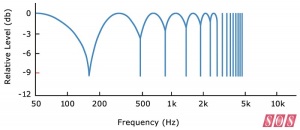This Sunday at The Carrack Gallery, the workshop “Human Origami: From Movement to Art” will be happening. Glenna Batson conceived of the project as a way to shift perceptions of the human body and the creative spirit through the act of folding and unfolding. When she asked me to create a soundscape for the workshop, I became intrigued with the idea of how sound can fold and unfold in acoustic space. What aspects of sound might figure into the perception that a soundscape is folding and unfolding around the listener?
First, what does it mean to fold? Some dictionary definitions: 1. To bend over or double up so that one part lies on another part: fold a sheet of paper. 2. To make compact by doubling or bending over parts: folded the laundry; folded the chairs for stacking. 3. To bring from an extended to a closed position: The hawk folded its wings.
One early approach I took when composing the soundscape was to create rising and falling tonal lines, then stagger those lines in different voices. The listener hears a simple tetrachordal theme and then hears it overlapping itself in another voice, thus creating that sense of doubling up. I use this technique alot in my soundscapes due to my deep study of Terry Riley’s In C and the influence it continues to have on my ear.
This overlapping relationship can be emphasized by increasing and decreasing the amplitude of a particular voice in motion. “Riding the faders” creates swells so that one voice overtakes and subsumes another voice. This technique follows a more geological definition of fold, where one part pushes over another part, like two tectonic plates.
Rising and falling are part of the movement pattern of folding, so I emphasized this with not only tones, but percussion as well. Chimes, rainstick, a rush of clatterings that then slow down and fade away – all give that sense of extending out and returning back to the starting point – so important in traditional origami.
A fold has wave-like qualities. Peaks and valleys are created in the making of a fold. I extended this metaphor in choosing the voices for the soundscape and in the way I am performing it on Sunday. I chose primarily instrumental voices that sustain a long clear tone or that have unusual and uneven transient trails. The woodwind can hold one tone forever, and that tone can swell and ebb. Another voice, called Underwater Bells, has extended trails that contain the sound of “shattering”. As I perform the scape I am adding and subtracting voices to fill and empty the sonic space, riding the faders to create ebbs and flows in amplitude, and applying audio effects to further induce this sense of folding and unfolding.
Having performed soundscapes at The Carrack in the past, I am familiar with its acoustic characteristics. The room is a very satisfactory space for sound. There is a good balance of reflective and absorptive materials so it is lively without being overwhelming. I have been studying acoustics off and on for several years, so I started thinking about how sound folds acoustically. Sound is a waveform so we already have folds happening. Sound waves bounce around in acoustic space via reflection, refraction and diffraction. The surfaces of the room reflect and absorb the waves, and the waves change shape and direction and interact in constructive and destructive relationships. Some additional characteristics of the space are its shoebox shape (generally helpful for acoustic integrity) and its creaky wooden floors, which will be a part of the soundscape in the space.
There is a full wall of windows at one end of the gallery, and I have two speakers to work with. The exact same sonic material will be diffused through each speaker, and the amplitude of each speaker will be controlled seperately. There is the potential to create strong early reflection sound waves by pointing one speaker directly at the windows while the other speaker is directed into the room. Reading about early reflections and the impact they can have on sound perception, there are two effects that may occur here. One is that low end frequencies will be strengthened and enhanced. The other effect is comb filtering.
Comb filtering is a sound “distortion” produced by combining an acoustical signal with a delayed replica of itself. The constructive and destructive interference patterns create peaks and valleys in the frequency response. When plotted out, the pattern takes on the shape of a comb. While comb filtering is undesirable in hi-fidelty listening, it does lend itself to a fold-like sound response, which is what I am going for in this case. While the specifics of the folds will be random, the folds will be maleable through changes in spectral content and changes in amplitude relationship between the two speakers, which will occur during the performance of the scape.My intention is that Folding/Unfolding will inhabit the space as an ocean of frequencies ebbing and flowing around and through the participants as they explore folding and unfolding in the physical space of their own bodies in motion. After the exploration, lead by Glenna, there will be a time to express what has been discovered through drawing, writing, coloring and toning as the movement experience transforms into a personal creative experience.
Please come and meet us there. The Carrack Gallery at 2 pm March 27, 2016.
References:
Master Handbook of Acoustics (5th Edition), F. Alton Everest and Ken C. Pohlmann

